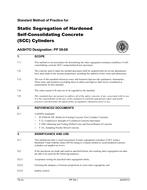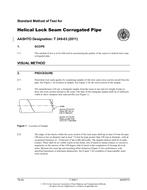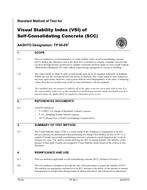AASHTO T 236-08 (2013)
- Standard Method of Test for Direct Shear Test of Soils Under Consolidated Drained Conditions (ASTM Designation: D 3080-72 (2003))
- standard by American Association of State and Highway Transportation Officials, 2008
- Publisher: AASHTO
$21.00$42.00
The test results are applicable to field situations where complete consolidation has occurred under the existing overburden and failure is reached slowly so that excess pore pressures are dissipated. The test is also useful in determining the shearing resistance along recognizable weak planes within the soil material.
Note--If failure is forced to occur on or near a horizontal plane at the middle of the specimen, it may not necessarily occur along the weakest plane, thereby overestimating shear strength parameters. Only when weak plane(s) are recognizable within the soil mass or interfaces between dissimilar materials are being tested, and the plane or interface at question is placed within the limits of the forced failure zone, can the shear resistance along these planes or interfaces be evaluated. The usefulness of direct shear test results was discussed in the Symposium on Direct Shear Testing of Soils; the proceedings appear in ASTM Special Technical Publication 131.
The test is not suited to the development of exact stress-strain relationships nor for evaluating any other associated quantities like moduli within the test specimen because of the non-uniform distribution of shearing stresses and displacements. The slow rate of displacement provides for dissipation of excess pore pressures, but it also permits plastic flow of soft cohesive soils. Care should be taken that the testing conditions represent those being investigated.
This specification is similar, except for SI units, but not technically identical to ASTM D 3080-72 (2003).
Related Products
AASHTO PP 58-08
Standard Specification for Static Segregation of Hardened Self-Consolidating Concrete (SCC) Cylinder..
$20.00 $40.00
AASHTO T 249-03 (2016)
Standard Method of Test for Helical Lock Seam Corrugated Pipe..
$26.00 $52.00
AASHTO TP 80-09
Standard Method of Test for Visual Stability Index (VSI) of Self-Consolidating Concrete (SCC)..
$20.00 $40.00
AASHTO PP 60-09 (2011)
Standard Practice for Preparation of Cylindrical Performance Test Specimens Using the Superpave Gyra..
$32.00 $63.00




